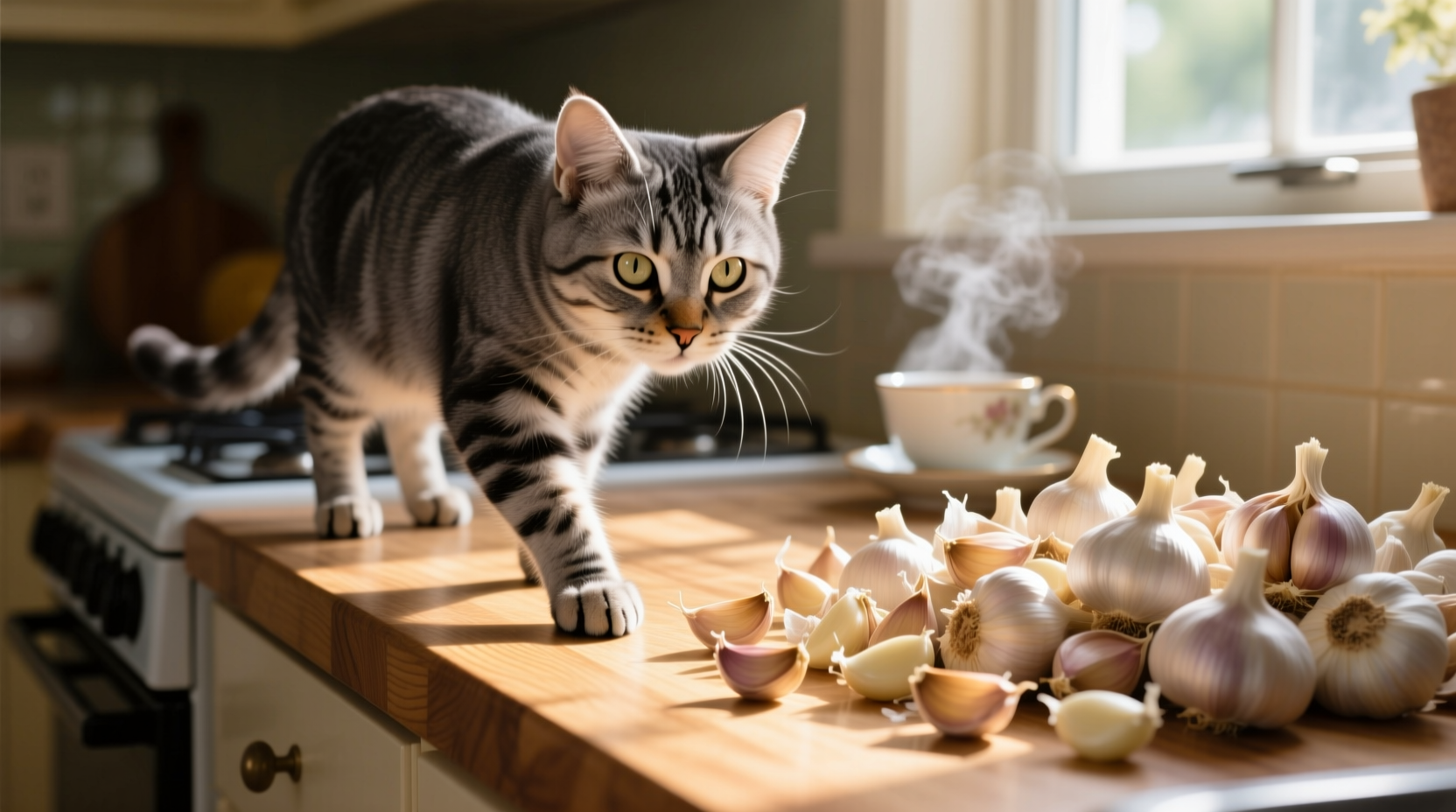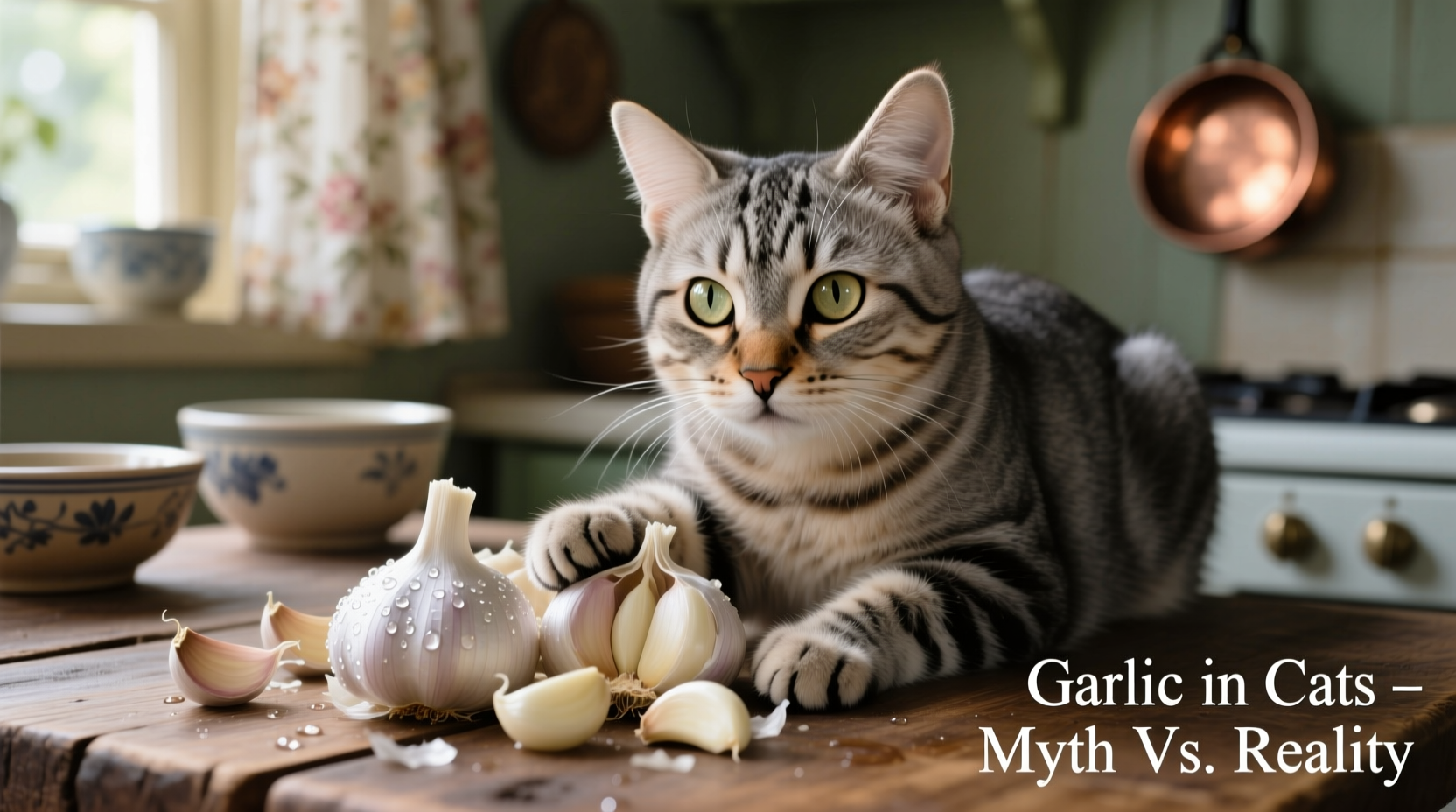As a pet owner, discovering your feline friend has nibbled garlic can trigger immediate concern. Understanding the real risks and appropriate responses could save your cat's life. This comprehensive guide provides evidence-based information on garlic toxicity in cats, helping you make informed decisions about your pet's safety.
Why Garlic Poses Serious Danger to Cats
Garlic belongs to the Allium family, which includes onions, leeks, and chives—all toxic to cats. The compound N-propyl disulfide found in garlic causes oxidative damage to red blood cells, leading to hemolytic anemia. Unlike humans, cats lack sufficient enzymes to metabolize these harmful compounds.
"Cats are particularly vulnerable to Allium species because their red blood cells are more susceptible to oxidative damage," explains Dr. Jennifer Coates, DVM, a veterinary advisor for PetMD. This biological vulnerability means even seemingly harmless amounts can trigger serious health consequences.
| Allium Type | Toxicity Level for Cats | Minimum Dangerous Amount |
|---|---|---|
| Garlic (fresh) | High | 15-30g per kg of body weight |
| Garlic powder | Very High | 5g per kg of body weight |
| Onion | Moderate-High | 5g per kg of body weight |
| Chives | Moderate | 10g per kg of body weight |
According to the ASPCA Animal Poison Control Center, garlic is approximately five times more toxic to cats than onions. This fact often surprises pet owners who mistakenly believe small amounts of garlic might provide health benefits.
Symptoms of Garlic Poisoning in Cats: What to Watch For
Symptoms typically appear 1-5 days after ingestion as damaged red blood cells accumulate. Early recognition significantly improves treatment outcomes. Key symptoms include:
- Pale or yellow-tinged gums (jaundice)
- Weakness and lethargy
- Rapid breathing or heart rate
- Dark-colored urine (resembling cola)
- Vomiting and diarrhea
- Decreased appetite
The progression timeline varies based on the amount consumed:
- 0-24 hours: Gastrointestinal upset may occur
- 24-72 hours: Red blood cell damage begins
- 3-5 days: Anemia symptoms become apparent
- 5+ days: Severe cases may develop organ damage

How Much Garlic Is Dangerous for Cats?
There is no safe amount of garlic for cats. However, toxicity depends on several factors:
- Concentration: Powdered garlic is significantly more dangerous than fresh cloves
- Frequency: Repeated small exposures can be as harmful as a single large dose
- Cat's size: Smaller cats face greater risk from the same amount
- Individual sensitivity: Some cats show symptoms from minimal exposure
Research published in the American Journal of Veterinary Research demonstrated that doses as low as 5g/kg of body weight can cause significant hematological changes in cats. For a 10-pound (4.5kg) cat, this represents approximately 22.5 grams of garlic—less than two average cloves.
Immediate Actions If Your Cat Consumes Garlic
If you suspect your cat has eaten garlic, follow these critical steps:
- Document the incident: Note the time, estimated amount, and form of garlic consumed
- Contact your veterinarian immediately: Do not wait for symptoms to appear
- Call animal poison control: ASPCA Poison Control (888-426-4435) or Pet Poison Helpline (855-764-7661)
- Do NOT induce vomiting unless specifically instructed by a professional
- Bring packaging or remaining substance to the veterinary appointment
Treatment typically involves intravenous fluids, oxygen therapy, and in severe cases, blood transfusions. Early intervention significantly improves prognosis, with most cats recovering fully when treated promptly.
Debunking Common Garlic Myths for Cats
Despite widespread misinformation, these garlic-related beliefs lack scientific support:
- "Small amounts boost immunity": No evidence supports immune benefits, while toxicity risks are well-documented
- "Natural flea prevention": Garlic doesn't effectively repel fleas and poses unnecessary health risks
- "Safe in commercial pet foods": Reputable pet food manufacturers avoid garlic due to safety concerns
- "Cooked garlic is safe": Cooking doesn't eliminate toxic compounds; may even concentrate them
A 2022 survey by the American Veterinary Medical Association revealed that 37% of cat owners incorrectly believed small amounts of garlic provided health benefits. This dangerous misconception continues to put cats at risk.
Safe Alternatives for Cat Health Support
Instead of risky home remedies, consider these veterinarian-approved approaches:
- Flea prevention: Use veterinarian-recommended topical or oral treatments
- Dietary support: High-quality commercial cat foods formulated for specific health needs
- Immune support: Omega-3 fatty acids from fish oil (under veterinary guidance)
- Digestive health: Probiotics specifically formulated for cats
Always consult your veterinarian before introducing any new supplement or making dietary changes for your cat. Professional guidance ensures safety while addressing your pet's specific health requirements.
Preventing Garlic Exposure: Practical Safety Measures
Protect your cat with these simple precautions:
- Store garlic and onions securely in closed cabinets
- Avoid preparing human food containing garlic where cats can access scraps
- Read pet food and treat labels carefully for garlic or onion derivatives
- Educate family members about the dangers of sharing human food with cats
- Be cautious with homemade pet food recipes containing any Allium species
Remember that garlic powder, garlic salt, and garlic-flavored products pose equal or greater risks than fresh garlic. Vigilance with all forms of garlic is essential for cat safety.
Frequently Asked Questions
Can cats have any amount of garlic safely?
No amount of garlic is considered safe for cats. Even small quantities can cause cumulative damage to red blood cells, potentially leading to hemolytic anemia. Unlike humans, cats lack sufficient enzymes to metabolize the toxic compounds in garlic safely.
How soon after eating garlic will my cat show symptoms?
Symptoms typically appear 1-5 days after ingestion. Initial signs include gastrointestinal upset within 24 hours, followed by more serious symptoms like pale gums, weakness, and dark urine as red blood cell damage progresses. Immediate veterinary consultation is recommended even if no symptoms are present.
Is garlic powder more dangerous than fresh garlic for cats?
Yes, garlic powder is significantly more concentrated and therefore more dangerous than fresh garlic. Approximately 5 grams of garlic powder per kilogram of body weight can cause toxicity, compared to 15-30 grams of fresh garlic. This means even small amounts of garlic powder in commercial pet foods or human foods pose serious risks.
What should I do if my cat ate garlic but seems fine?
Contact your veterinarian immediately even if your cat shows no symptoms. Damage to red blood cells may be occurring without visible signs. Early intervention significantly improves outcomes. Provide details about the amount consumed and when it happened to help your vet determine appropriate monitoring or treatment.
Are garlic supplements marketed for pets safe for cats?
No, garlic supplements are not safe for cats regardless of marketing claims. Reputable veterinary organizations including the ASPCA and AVMA warn against giving any garlic products to cats. Products claiming health benefits from garlic for pets lack scientific validation and pose unnecessary health risks.











 浙公网安备
33010002000092号
浙公网安备
33010002000092号 浙B2-20120091-4
浙B2-20120091-4